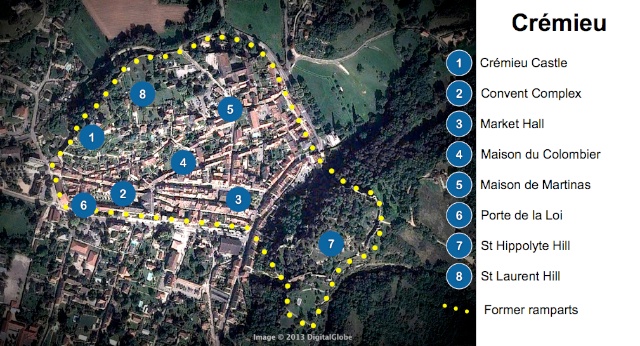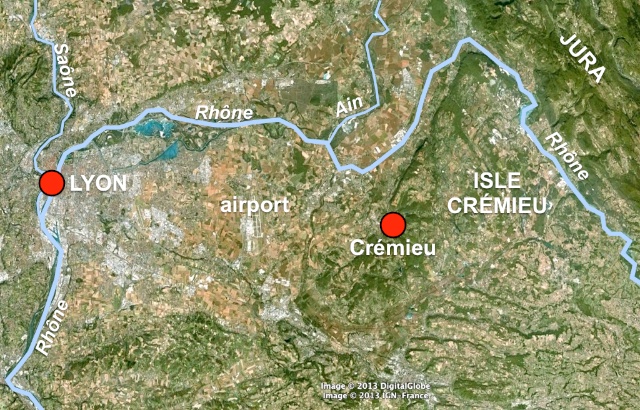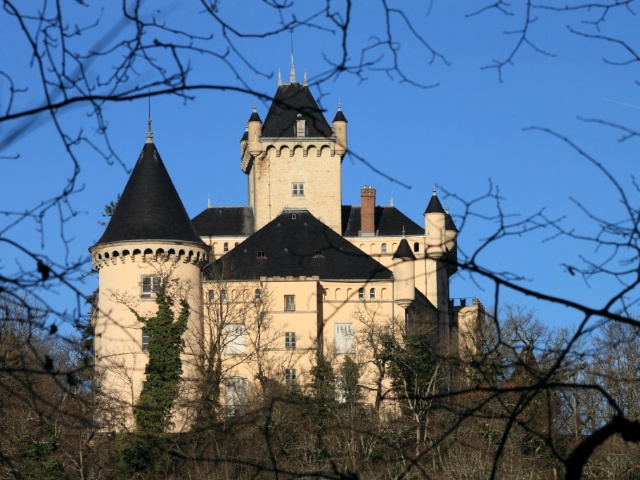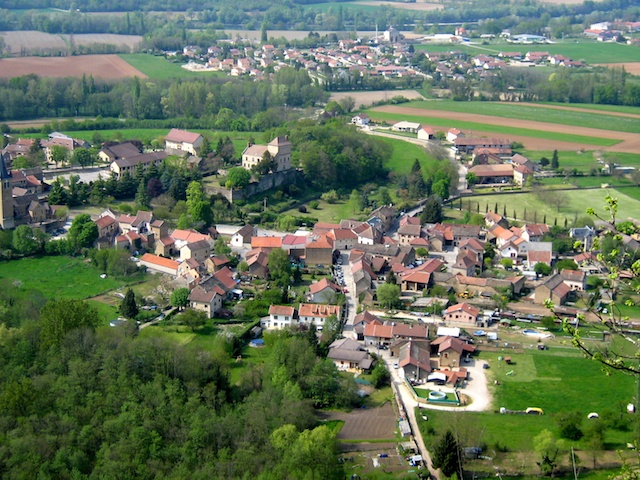Located some 40kms East of Lyon, the little medieval town of Crémieu is a jewel of rich architectural and historic heritage. The old streets of Crémieu still evoke the prestigious past of the town which was situated on a strategic route between Lyon and Italy.
History of Crémieu
![Crémieu © JeanBono, licence [CC BY-SA 3.0], from Wikimedia Commons](https://frenchmoments.eu/wp-content/uploads/2013/06/St-Hippolyte-Crémieu-©-JeanBono-licence-CC-BY-SA-3.0-from-Wikimedia-Commons1.jpg)
In the High Middle-Ages, Crémieu was part of the lands ruled by the Dauphins of Viennois, also known as Dauphiny (le Dauphiné). The hereditary title of the Lords (Dauphin de Viennois in French) derives from the region around Vienne, one of the main cities. (Vienne today in the département of Isère should not be confused with Vienna in Austria).
The first written mention of Crémieu (known then as Cremacum) dates back to the 12th century when it was an administrative centre of a Castellany located in the Tour du Pin Barony. In 1282, the Barony was annexed to the Dauphiné before being united with France in 1349.
A fortified Benedictine priory was founded on top of the cliffs of Saint-Hippolyte Hill. The castle was rebuilt in the 13th century on the Saint Laurent Hill opposite and the town started to grow on its southern slopes before enlarging between the two hills.
From then until 1349 when it united with France, the region of Crémieu endured wars between Savoie and Dauphiné.
In 1315 a charter granted new freedoms to the people of Crémieu as well as important trading privileges. This Act secured an era of prosperity for the following two centuries.
![Crémieu ville © JeanBono, licence [CC BY-SA 3.0], from Wikimedia Commons](https://frenchmoments.eu/wp-content/uploads/2013/06/Crémieu-ville-©-JeanBono-licence-CC-BY-SA-3.0-from-Wikimedia-Commons.jpg)
The construction of a new hall commenced in 1434, as well as the construction of ramparts two kilometres long, punctuated with nine gates and guarded by 14 towers.
This wall enclosed the old town, the castle, the Saint-Hippolyte cliffs as well as the site of a new town laid out next to the Augustinian convent.
Between 1337 and 1339, the economic prosperity of Crémieu was enhanced by the creation of a minting workshop.
From the reign of King Louis XII (1498-1515), Crémieu enjoyed a strategic position along the trade and military routes leading to Italy. The town gained an important role in corn trading between France, Savoie, Switzerland and Italy.
In the 15 and 16th centuries, a new district developed: the Lower Town (Ville Basse), accessible by the opening of new gates.
In the 17th century, trading in Crémieu became less important and was replaced by the activity of newly founded convents: Capuchin in 1615, White Penitents in 1619, Visitandine Sisters in 1627, Ursulines in 1633, Hospital of Notre-Dame du Reclus in 1675, followed by the completion of the Saint-Jean church towards the end of the 17th century.
![Crémieu from Blied © luigifab, licence [CC BY-SA 3.0], from Wikimedia Commons](https://frenchmoments.eu/wp-content/uploads/2013/06/Crémieu-from-Blied-©-luigifab-licence-CC-BY-SA-3.0-from-Wikimedia-Commons.jpg)
In 1702, the annual trade fairs, which had taken place there since the 14th century, were cancelled for good. This decision led the people of Crémieu to focus on their textile and leather industries. In 1710, tanneries, shoe manufacturers, spinning mills and wool and hemp card rooms employed nearly a quarter of the town’s population.
In the 19th century, the bucolic Isle-Crémieu plateau and its sleepy little capital attracted landscape painters such as Camille Corot and Gustave Courbet, as well as admirers of the picturesque countryside.
Crémieu Old Town

The charming Old Town is made up of picturesque little squares, narrow streets with the coloured façades of ancient houses and the ruins of the ramparts.
Old houses
The Old Town developed throughout the 13th century below the walls of the castle but many of the town’s old houses date from the 16th and 17th centuries.
The Maison du Colombier at the corner of rue du Four-Banal and Côte Faulchet dates back to the 15th century. It features mullioned windows and houses the town’s exhibitions. It owes its name to the truncated horseshoe-shaped tower which was built as a dovecote in the 18th century.
The Maison de Martinas was first mentioned in 1327 and is one of Crémieu’s oldest houses. It includes an interesting feature of a tripartite window with head-shaped sculpted capitals. Legend has it that the three heads evoke three notorious hangmen. The house shows remnants of shopping arcades which reveals its former use. The Martinas House is located along the rue du Marché-Vieux (Old Market Street), the shopping street of the medieval town.
The former sales stall houses on rue des Augustins retrace the trading history of Crémieu from the 13th to the 19th centuries. The ground floor of these houses was dedicated to trading activity, the first floor to living space and an adapted attic to store the goods with the help of a pulley with an outer rim.
The market-hall
The 15th century market-hall is an emblematic landmark in Crémieu and also France’s second largest hall (61m long and 19.5 m wide).
The imposing oak framework is covered with a 1200m2 “lauze” stone roof weighing over 400 tons and interspersed with three arcades.
Under the framework, the three alleys were dedicated to a defined trade.
To the right at the back of the hall are stone troughs on which corn measures were set up for weighing spouts to fill the bags.
Today, the market hall is the meeting place for the town’s market, but also hosts fairs, concerts and the medieval banquet in September.
The ramparts
The ramparts encircle the old town for over 3 km, even marrying in with the surrounding hills. They are flanked with squared and rounded towers at the top of the Saint-Hippolyte hill to the East and encircle the castle and the Saint-Laurent hill to the West.
In the old town, the ramparts used to border Cours Baron Raverat and include the church bell.
Segments of the old ramparts can still be seen, as well as some of the monumental gates from the 14th century.
Porte de la Loi (Law Gate)
![Porte de Lyon Crémieu © Charlotte de Savoie licence [CC BY-SA 3.0], from Wikimedia Commons](https://frenchmoments.eu/wp-content/uploads/2013/06/Porte-de-Lyon-Crémieu-©-Charlotte-de-Savoie-licence-CC-BY-SA-3.0-from-Wikimedia-Commons.jpg)
Dating back to the 14th century, this was the main entrance to the town. It was preceded by a ditch where the now underground Vaud River used to flow. The roof is covered by lauze stones. It is often known as “Porte de Lyon” (Lyon Gate) for it opens onto the road leading to Lyon.
Porte de Quirieu (Quirieu Gate)
This gate belongs to the town’s second set of ramparts. It was walled up in 1535 and replaced by the François 1er Gate before being restored in 1930.
In medieval times, it used to open onto the bustling rue du Marché Vieux.
Porte Neuve (New Gate or François 1er Gate)
![Crémieu Porte François 1er © Daniel Culsan licence [CC BY-SA 3.0], from Wikimedia Commons](https://frenchmoments.eu/wp-content/uploads/2013/06/Crémieu-Porte-François-1er-©-Daniel-Culsan-licence-CC-BY-SA-3.0-from-Wikimedia-Commons.jpg)
This gate owes its name to the French King who passed under it at the events during the Italian Wars. The structure dates back to 1535 and features medieval defensive elements such as chemin de ronde and machicolations. The gun-loops in the exterior wall precede the introduction of fire weapons in European conflicts.
Former St. Jean Church
The establishment of a second parish church was decided in 1504. Lack of finances postponed its consecration until 1680 by the Archbishop and Count of Vienne. Today the building is used as a private house and has been completely restored.
The Convent Complex
The convent complex of Crémieu comprises the Augustinian Convent, the cloister and the church. It is located on Place de la Nation, which took its name from the era of Revolution.
The Augustinian Convent
The Augustinian convent which now houses the Town Hall is arguably the most prestigious monument in Crémieu. Founded in 1317 by Dauphin Jean II, it was later enlarged and embellished by his son Humbert II who envisioned the convent to welcome 40 monks.
Two rooms are open to the public: the “Salle du chauffoir” (Warming Room) the huge 17th century fireplace of which was used to heat the monks’ cells located on the first floor.
The second room that can be visited is the former Chapter House (Salle Capitulaire) which serves today as the town’s Council Chambers (Salle du Conseil municipal). The ceremonial room is adorned with fine coffered wooden ceilings with Italianate decoration dating from the Renaissance era, oak stalls, paintings, armour from the 16th century and weapons used during the French Revolution. The room opens into the cloister.
The cloister
The cloister of the former Augustine Convent has been kept intact across the centuries and is accessible from Place de la Nation through a fine wrought iron railing from 1715.
It was built during the 17th century and served as a prison during the French Revolution. The funerary slabs that have paved the ambulatory since the 19th century come from the adjoining church. Corporation signs can still be seen engraved in them, as well as the Augustinian symbol: a heart surmounted by a flame and pierced by two arrows.
The church
Dating back to the 14th century, this sanctuary was assigned to be the chapel of the Augustinian convent. Its outstanding feature is its North-South orientation rather than the traditional East-West. The church backed onto the rampart and the bell tower was built on top of the line of defence in 1508.
Inside, it is interesting to note that the pillar shapes are different from each other. The side aisles are narrow with tight cross-ribbed vaults.
It became the parish church of Crémieu during the French Revolution when the Convent complex was bought by the municipality.
![Les Prophètes fresco in Crémieu's church © GO69, licence [CC BY-SA 3.0], from Wikimedia Commons](https://frenchmoments.eu/wp-content/uploads/2013/06/Crémieu-Fresque-Les-Prophètes-Eglise-©-GO69-licence-CC-BY-SA-3.0-from-Wikimedia-Commons.jpg)
During the 19th century, the wooden oak ceiling was replaced by neo-Gothic vaults. Augustinian frescos were recently discovered on the choir walls of the church. Italian experts who came to study them revealed that these paintings are unique examples of their kind in France.
The fortified priory
![Tower on St Hippolyte Hill, Crémieu © Frachet, licence [CC BY-SA 3.0], from Wikimedia Commons](https://frenchmoments.eu/wp-content/uploads/2013/06/Crémieu-Tour-à-fenêtres-©-Frachet-licence-CC-BY-SA-3.0-from-Wikimedia-Commons.jpg)
The fortified priory was built on the top of the cliffs of the Saint-Hippolyte hill which extends to the West side of Crémieu and faces the castle hill. The Benedictine priory was abandoned in 1247 when the monks left for the mother abbey of Saint Chef.
The top of the Saint-Hippolyte hill is the best vantage point to view the town of Crémieu, preferably in the morning when the first rays of sunlight caress the roofs of the old town.
Crémieu Delphinal Castle
![Château Delphinal Crémieu © Charlotte de Savoie, licence [CC BY-SA 3.0], from Wikimedia Commons](https://frenchmoments.eu/wp-content/uploads/2013/06/Château-Delphinal-Crémieu-©-Charlotte-de-Savoie-licence-CC-BY-SA-3.0-from-Wikimedia-Commons.jpg)
Dominating the old town of Crémieu on its East side from the Saint-Laurent hill is the castle formerly belonging to the Tour du Pin lords who rebuilt it from 1282. It is called “château delphinal” because the “dauphin” used to reside here. The fortress was a symbol of the Dauphin’s authority when Crémieu was located on the border with the County of Savoie. Naturally, it served as a refuge for the Dauphiné.
It was dismantled by Richelieu in the 17th century and served as a stone quarry until the Revolution when it was acquired by private owners. The castle was partly restored in 1904 and listed among the the “Monuments Historiques” in 1943. From the terrace where there is a chapel dedicated to Notre-Dame-de-la-Salette, one can enjoy a fine view over the “lauze” stone roofs of the church and the old convent..
Today, the castle is privately owned and is not open to the public.
Isle Crémieu

The vicinity of Crémieu, known as “Isle Crémieu” is a limestone plateau stretching between the plain of Lyonnais and the Jura mountains in Bugey bordered by the Rhône River.
The countryside is a combination of hills and valleys dotted with small lakes, peat bogs, fields bordered by stone slabs driven into the ground and small manor houses with lauze stone roofs.
A drive through a few villages and sites provide a nice day out:
Château de Saint-Julien

Overlooking the peaceful lake of “étang de Ry” on the road to Siccieu-Saint-Julien-Carisieu, this 13th century castle was partially dismantled during the French Revolution before being heavily restored by the countess of Chaponay from 1836 (the actual keep did not exist originally).
Ciccieu-Saint-Julien-Carisieu
This little village is located six kilometres East from Crémieu. It features a Romanesque chapel from the 13th century in the hamlet of Carisieu.
Saint-Baudille-de-la-Tour
This peaceful village of 700 inhabitants located in the heart of the Amby Valley includes a fortified house of “des Dames”, a tourist farm from the 15th century whose tower is covered with lauzes. One of the paintings displayed at the Louvre Museum in Paris represents a local pond.
The Chemin de fer du Haut-Rhône is a train pulled by a steam locomotive which runs along the Rhône River for over 4 kilometres between the station of Montalieu Vallée Bleue and Pont de Sault Brenaz.
La Balme-les-Grottes
La Balme-les-Grottes, with its stone houses and Romanesque church, is nestled at the foot of the plateau’s cliffs. The village is famous for its caves (Grottes de la Balme), known as one of the seven wonders of Dauphiné.
Known as early as the Middle-Ages, the remarkable caves were visited by King François I in 1516. They feature an underground lake, small ponds, galleries, stalactites and stalagmites that can be discovered on a 90 minute track with 270 steps.
The Larina archeological park

Located near Hières-sur-Amby about 30 kms from Lyon, the Larina archeological park is situated on 21 hectares on top of a rocky spur overlooking the Lyonnais Plain. The site has had a human presence since Neolithic times (circa 3000 BC). Between the 5th century BC and the 1st century AD, an oppidum was built on the plateau, with walls encircling wood and dried mud huts. A temple dedicated to Mercury was erected there during the Roman occupation.

The artifacts found at Larina are now exhibited in the “Musée-Maison du Patrimoine” in Hière-sur-Amby.
The panoramic view from the belvedere at the northern point of the cliff takes in the Rhône River, the Bugey Nuclear Plant, the Bugey mountains, the foothills of the Dombes and the ranges of Beaujolais and Lyonnais.
The Amby Gorges
Between Hières-sur-Amby and Optevoz (D52A), the Amby River winds around the feet of the cliffs. This picturesque road is soon interrupted by the appearance of the fortified manor of Brotel, originally built in the 13th century and restored in the 16th century. Overhanging the cliff, the mansion has aptly been nicknamed “the Eagle’s Nest”.
The manor is one of thirty fortified houses which have survived since the Middle-Ages. Medieval sources show there were more than 50 of them in the vicinity of Crémieu. The houses belonged to the local nobility who occupied a significant political role in the Dauphiné. Combining a residential and defensive function, these houses were usually built on a high cliff near a road and featured one or two towers and a wall to protect their occupants when the wars raged between the Dauphiné and Savoie.


